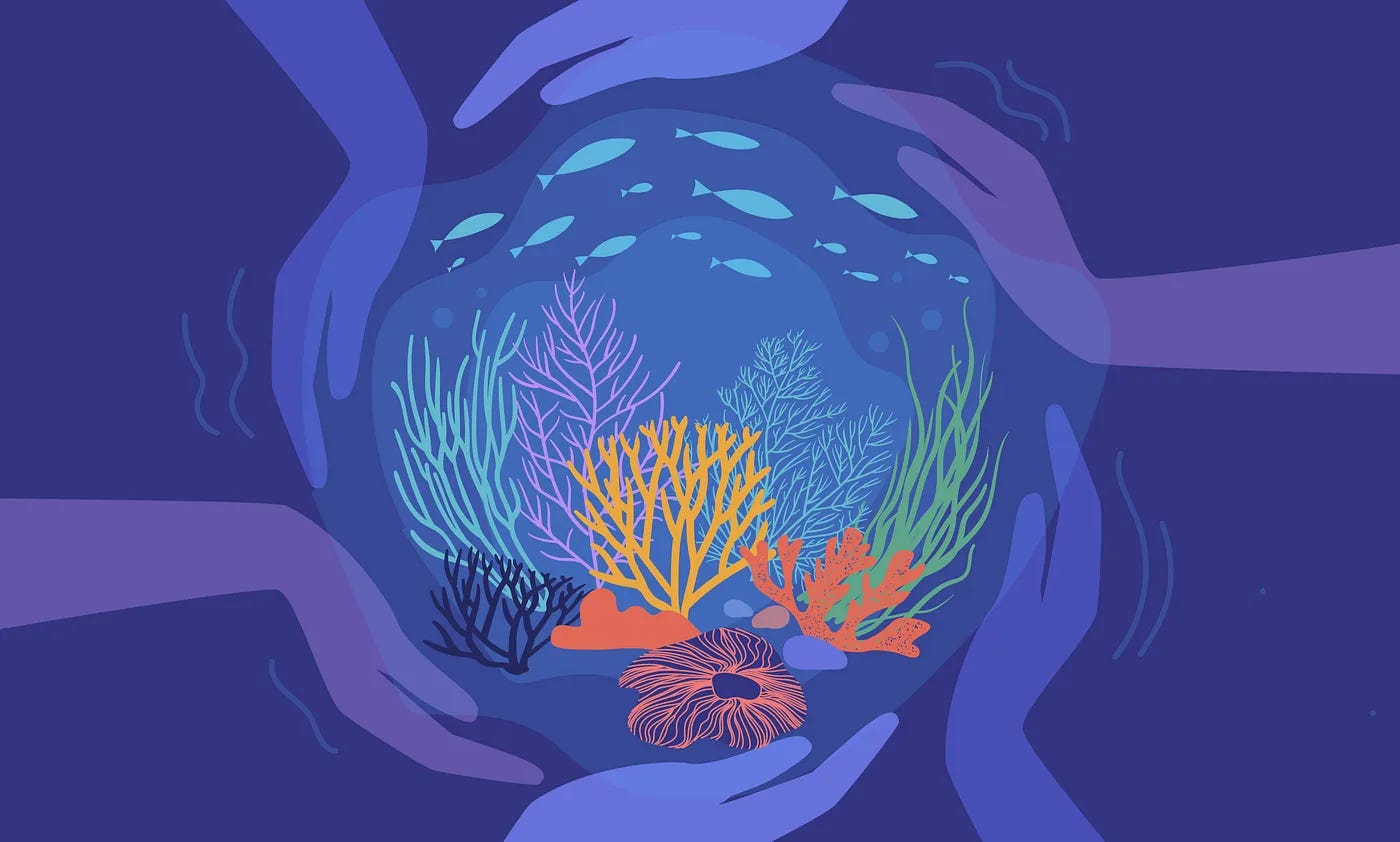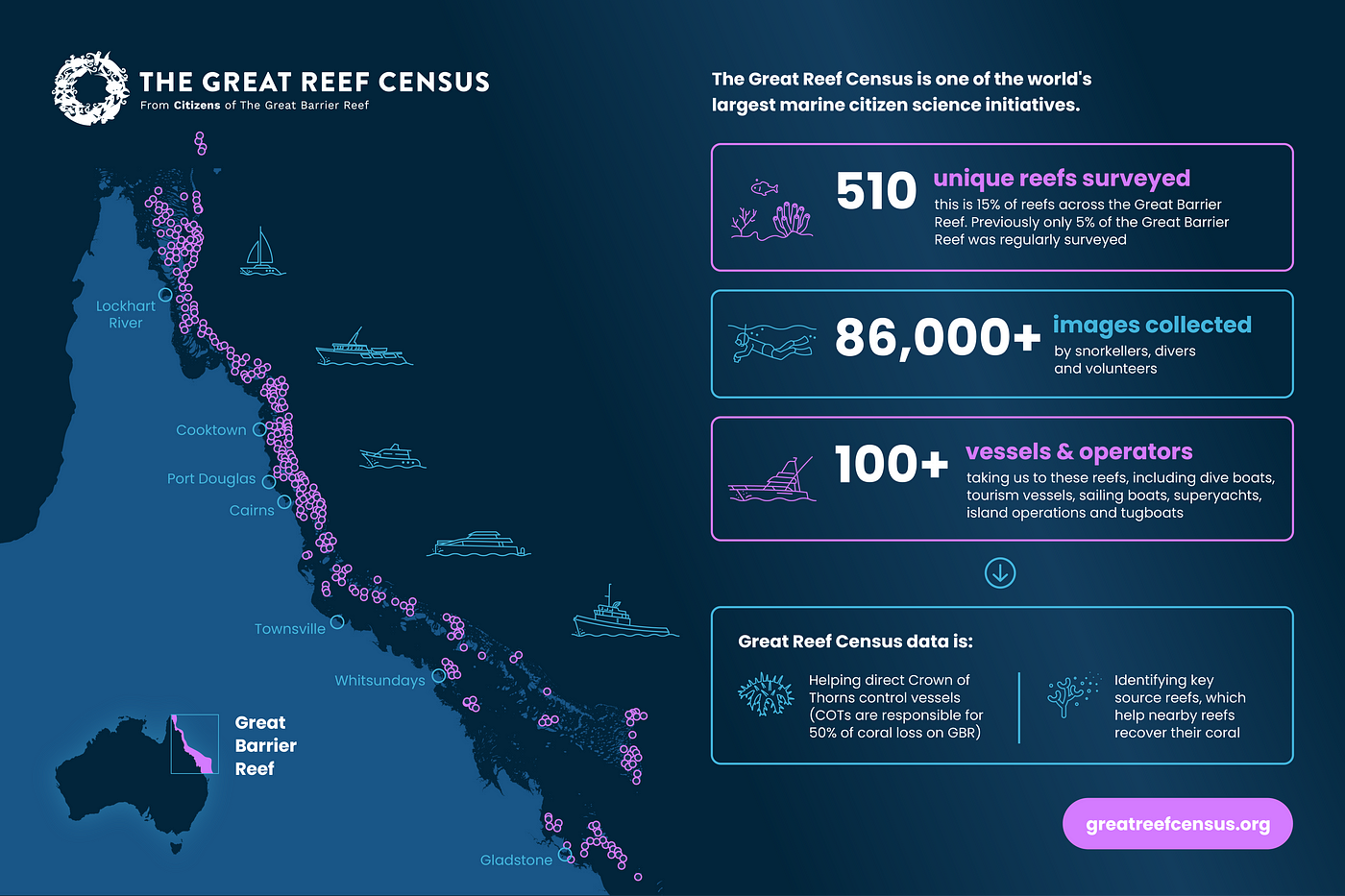The Great Barrier Reef, Australia’s iconic ecological site and the world’s largest marine ecosystem is buckling under the effects of climate change and other factors. According to a report published by government scientists, the natural landmark suffered its sixth mass bleaching event in 2022 with 91% of reefs affected by coral bleaching.
Driven by this sentiment, Citizens of the Great Barrier Reef entered the fray to gather data about the reef for scientists to analyse it and find solutions. Its flagship initiative, The Great Reef Census, mobilises makeshift research flotillas to capture tens of thousands of survey images from across the reef that are then analysed online — both objectives achieved by thousands of everyday people alongside scientists.
The Great Reef Census is powered by an intricate ecosystem of on-board computing devices, an ML platform and a data platform. Citizens GBR needed a tech partner who could not only tie these various components to work together seamlessly but also revamp the existing data platform to handle scale and other challenges as more and more citizens joined hands.

Phase I — Getting the basics right!
Since its launch in 2020, the Great Reef Census has made significant progress; 510 unique reefs have been surveyed with over 86,000 images! But it wasn’t always this smooth sailing.
Citizens GBR had executed two successful Great Reef Census surveys, GRC 1 and GRC 2, but the data collected as part of this initiative was not serving its intended purpose for scientists. The initiative had become a victim of its success. While it showed great success and possibilities, the analysis platform made it extremely tricky for everyday citizens to engage with the data and analyse the images from the surveys; the process was complicated and the user interface was extremely difficult to navigate.
Another key challenge was that the codebase and deployment processes had become overly complicated, not allowing the Census to scale and achieve its amazing potential. Citizens GBR team hit a roadblock as basic changes/features vital to the cause could not be added to the platform. Scientists were unable to track newer, different species as part of the Reef Tracks initiative. Adding new marine species to the system was impossible.
Simple tasks such as making website changes were out of the question too, and as the ecosystem surrounding the cause evolved, this became a major hurdle and brought the organisation and the cause to a grinding halt.
Responding to an SOS call from Citizens GBR, consultants from Sahaj stepped in and worked rapidly to simplify and streamline the deployment processes. Working as an intrinsic part of the team, they gained an appreciation and understanding of the project’s expansive breadth in just a couple of days to remove key hurdles. These interventions spanned a wide array ranging from simplifying the process of making changes to the website and the platform, to implementing targeted and significant changes to the Google Firebase infrastructure and automating the deployment processes for the website.
The platform was now back on track and Citizens GBR could make vital changes and deploy them to production in a couple of minutes. The lean 2-member team from Sahaj further worked towards enabling the addition and tracking of new marine species on the platform by creating basic user and technical documentation and by doing so, empowered the Citizens GBR team to start owning and making changes themselves.
Within a week of initiating action, Citizens GBR was back in business, ready to take the next steps in its monumental journey. This initial engagement would set the stage for a long-term collaborative relationship between Citizens GBR and Sahaj as its technology partner.
Phase II — Shifting gears!
With the basics in place, and the business back up and running, it was time to simplify the challenges faced by the two key stakeholders of the Citizens GBR ecosystem — marine scientists and citizen conservationists.
While the Great Reef Census had successfully collected over 40,000 images, the existing analysis process was overly convoluted; citizens were expected to classify corals across 40+ categories! The user interface was cumbersome for the average citizen scientist as she/he was expected to draw coral boundaries freehand with a mouse before identifying and categorising the coral cover in each image. As a result, less than 2% of the analysis done by citizens served any purpose.
Along with their key partners including Sahaj, the Citizens GBR team led the re-imagination of the analysis user experience. This new experience, built with an ML platform at its core, would preselect and identify different coral regions in every image into polygons. Then, it would feed that information into a simpler user interface for citizen scientists to categorise the polygons into 7 categories, making the whole analysis process infinitely simpler, more accurate and faster.
Consultants from Sahaj created this simpler user interface and the visualisations for the underlying data platform and further integrated the ML platform into the Citizens GBR firebase ecosystem. To do this, the team unravelled the preexisting complex codebase and refactored it as they rebuilt large sections of the Great Reef Census website while ensuring that the platform was repeatable, extensible and testable. This refactoring enabled the creation of multiple user interfaces: one for marine scientists that would also help train the ML model, and another for enabling Citizens GBR team to test and improve the new user interface.
While the improved user experience breathed new life into the website and citizen interaction, Sahaj also created the data platform and interfaces using Python and Google Bigquery. This data platform served as a conduit between the ML platform and the user interface, making the analysis useful and consumable by scientists.
This new analysis process worked seamlessly and enabled the Citizens GBR team to launch the experience for school students in Queensland to contribute to the survey. This produced a specific analysis that marine scientists could use to inform their actions to save the reef, closing the loop from gathering the images, analysing them and driving action.
These interventions let Citizens GBR extract, analyse and leverage the Great Reef Census data to lend gravity to the concept that Citizen Science can and should be used to aid Marine Science and set up the new user interface which would become the backbone for the Great Reef Census.
Phase III — Scaling up!
After the success of the first two Great Reef Censuses, the launch of the Great Reef Census (GRC3) was on the anvil. However, GRC3 faced two key challenges. Firstly, now that the data was being used by marine scientists, the census had to capture some additional information. It was also important to do it differently than the first two iterations. Secondly, the process of capturing images of the reef and uploading them on the platform was inefficient and hard to navigate. Surveyors were capturing the images and surveying the reefs while navigating a complex ecosystem of non-reliable processes and infrastructure.
This ecosystem that enabled the survey with its various components–on-board servers/computing devices and the platform that consumed and analysed the data–was falling short of enabling the goals and the vision of the Citizens GBR team, and instead making things harder for people.
Consultants from Sahaj worked closely with the Citizens GBR team to reimagine and implement a new data upload process that would make data collection user-friendly and easier. The team also fine-tuned and automated the configuration and installation of Linux-based Edge devices that enabled research boats to gather images from various reefs using GoPros and upload them with significant ease. Further, the boats equipped with these Edge computing devices could now be deployed rapidly as the solution was repeatable and scalable. This meant that the survey teams on the reefs could spend more of their time in the water running the surveys rather than making the technology and the devices work; this made the surveys 100% more efficient!

Phase IV — Back to the future!
Getting the underlying technology to becoming an enabler of a very successful set of initiatives has put us back on track towards the future we’ve all been dreaming of. The template of GRC3 is now ready to be showcased and implemented beyond Australia to bring in more help and realise Citizens GBR’s ambitious dream. It is essential not just to present the data to marine scientists and data analysts worldwide but to also grow the community of citizen conservationists who can pitch in to save the Reef.
Sahaj’s consultants have channelled their capability in platform and data engineering to prepare the platform for this experience; it needs to be resilient, scalable and easy to maintain for the Citizens GBR team. Additionally, the web experience with its rich features like image analysis augmented by AI needs to be brought alive for users worldwide on their mobile devices.
It has been a monumental journey to partner with Citizens GBR and work on a problem statement of such unprecedented magnitude. The intricate ecosystem involving various stakeholders and tech components (both hardware and software) that enables this herculean effort requires careful orchestration with an eye for the future as the effort gains scale. Sahaj is a proud partner in this mammoth collaborative effort and is thrilled to bring its engineering expertise into the mix to conserve The Great Barrier Reef.




